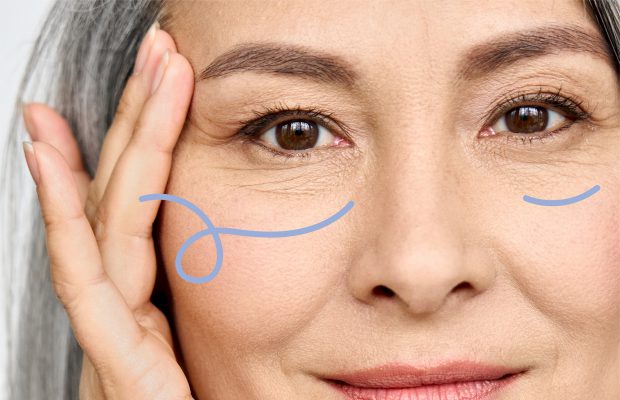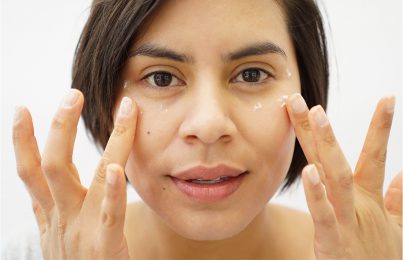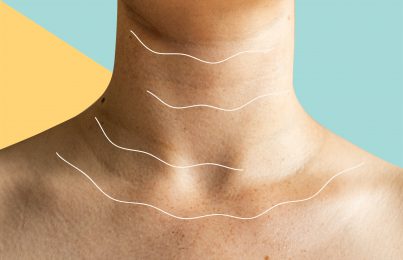Updated 04/11/24. Of all the areas of the face, the eye area can be the most problematic, due to visible puffiness and stubborn under-eye bags that develop as we age. In fact, because the skin is so thin in this area, it’s actually the first to show signs of aging! In this post, I’ll explain why puffy eyes happen in the first place. I’ll also share eight expert tips for reducing and preventing visible puffiness. Keep reading to learn all of this and more.
The Difference Between Under-Eye Puffiness and Bags
Did you know there’s a difference between under-eye puffiness and under-eye bags? Did you also know that long-term puffiness can lead to under-eye bags? Let me explain.
Under-Eye Puffiness
Puffiness is considered a temporary condition. It is most prominent for the first 2-4 hours after waking up. It’s brought on by things like salty foods (particularly eating salty foods at night), yawning, allergies, and crying. Sleep also plays a role in causing puffiness, since your body is laying flat for 7-8 hours, causing improper fluid drainage. Once you wake up and maintain an upright position, the puffiness should improve.
Under-Eye Bags
The term “under-eye bags” refers to loose, sagging skin that has lost its firmness and elasticity. Under-eye bags start out as under-eye puffiness. Over time, chronic puffiness will stretch out the skin tissue to the point where it will no longer spring back. In fact, the connective tissues that attach the skin to the orbital bone actually deteriorate. This results in a pouch of fat known as “fat pads.” These usually begin to appear when people are in their 40s, which is when the skin naturally starts to lose its tone.
Unfortunately, under-eye bags are considered permanent. Once they’ve formed, it’s impossible to restore the loss of elasticity with topical products alone. Cosmetic surgery is considered a tried-and-true option.
How to Reduce and Prevent Under-Eye Puffiness
1. Get Plenty of Sleep and Avoid Yawning
Believe it or not, yawning can cause under-eye puffiness. It makes the eyes tear and swell up, and this excess fluid weakens elasticity under the eyes. The goal is to keep the skin tissue firm and intact, so make sure you’re getting enough rest to avoid excessive yawning whenever possible. Getting a good night’s sleep is always good advice, anyway!
2. Keep Your Head Elevated While You Sleep
Remember how I said sleep plays a role in under-eye puffiness since your body is laying flat for 7-8 hours, causing improper fluid drainage? One way to get around this is to keep your head elevated while you sleep. Try sleeping on two pillows at night to encourage proper fluid drainage and reduce unnecessary fluid retention come morning.
3. Shower in the Morning
When you shower, heat from the water dilates lymphatic vessels to assist with the draining of fluid, waste, and toxins that build up in the vessels. If you wash your face in the shower and water directly hits your face, it will also stimulate excess fluid to move out of the eye area. Then, there’s the matter of your vertical position. Even just standing in the shower is beneficial for encouraging extra fluid drainage. That’s why simply taking a shower in the morning is an effective way to reduce under-eye puffiness.
When you get out of the shower, splash your skin with very cold water. This will shrink capillaries to help further reduce puffiness. Basically, you’re opening up the vessel walls with hot water and then closing them again with cold water.
4. Apply a Cold Compress
Cold temperatures constrict blood vessels, preventing the flow of fluid into the skin tissue. This can quickly diminish the appearance of under-eye puffiness. So, if you wake up with puffy eyes, try gently pressing a bag of frozen peas to the area. Some people like to put a spoon in the freezer and use this to target puffiness. This works, too, as will anything that’s cold, including ice rollers and other cryo tools and devices.
5. Avoid Oil-Based Eye Creams
You might think rich, oil-based eye creams are exactly what your puffy eyes need, but that’s not the case. They cause what I call “eye cream puffiness syndrome.” In other words, the skin around the eyes doesn’t absorb the eye cream all the way, because it’s too thick, and it travels directly into the eyes. This leads to unnecessary puffiness.
So, instead of reaching for a rich, oil-based eye cream, use a lightweight, moisturizing one instead. I recommend using one with firming agents, like peptides, to help the skin around the eyes look firm. You can find peptides, as well as antioxidants, and hydrating ingredients in the Hydrabounce Firming Eye Creme, which is the eye cream I personally use.
Read what to look for in an eye cream.
6. Exfoliate the Under-Eye Area
Along with preventing under-eye puffiness, most people also want to keep the area looking smooth and healthy. To do this, you need to exfoliate the eye area to prevent dead skin cell build-up, which can lead to crepey-looking skin. Many people aren’t aware that exfoliation can make such a big difference! I recommend using the Overnight Eye Serum. It contains a blend of glycolic and lactic acids to target unwanted texture issues that come from things like fine lines, dryness, and milia.
7. Avoid Eating Salty Food at Night
This is a big one if you want to wake up without under-eye puffiness. The sodium that’s found in salty foods encourages water retention under the eyes, resulting in excessive swelling of the eye tissue. That’s why I usually try to avoid eating salty foods at night. I also try to drink a lot of water in order to flush my system.
On that note, some of my clients have told me that eating gluten gives them puffy eyes. This may be something you want to consider if you struggle with puffiness. (Learn more about how food affects the skin.)
8. Do Your Best to Control Allergies
One of the biggest contributors to under-eye puffiness (and eventual under-eye bags) is congestion from allergies. This congestion can also cause dark circles, which are sometimes referred to as “allergic shiners.” They are definitely a contributing factor to the deterioration of under-eye skin tissue.
The Bottom Line
The appearance of puffy eyes can be alleviated, but the appearance of bags can’t—unless you turn to professional options such as cosmetic surgery. However, you can prevent under-eye bags from appearing in the first place if you follow my puffiness-prevention tips. As always, prevention is everything.
There’s one more thing I want to mention regarding under-eye bags. In some cases, under-eye bags can be caused by hypothyroidism (an underactive thyroid) as well as lymphatic system and kidney or liver problems. Consult a doctor if you think an underlying condition is a culprit behind your under-eye bags.
Next, find out why you’re eye cream isn’t working.
Celebrity Esthetician & Skincare Expert
As an esthetician trained in cosmetic chemistry, Renée Rouleau has spent 30 years researching skin, educating her audience, and building an award-winning line of products. Her hands-on experience as an esthetician and trusted skin care expert has created a real-world solution — products that are formulated for nine different types of skin so your face will get exactly what it needs to look and feel its best. Trusted by celebrities, editors, bloggers, and skincare obsessives around the globe, her vast real-world knowledge and constant research are why Marie Claire calls her “the most passionate skin practitioner we know.”




Comments:
After using dermalmd for several weeks, the puffiness under my eyes and on my eyelids was definitely reduced. I use it every morning and night. It doesn’t make the puffiness totally disappear, it just lessens it, which is more than any other thing I’ve tried. I can tell the difference!
Posted By: Laureen |
i havE an underactive thyroid gland and i have all the puffy eyes and the dark circles what can i use to help in this case i use cold tea bags but still seem to have them
Posted By: Margaret Quinn |
So then it’s probably only something that surgery can correct.
Posted By: Renée Rouleau |